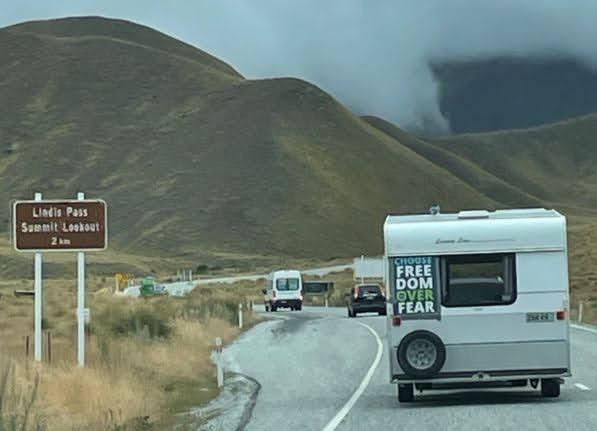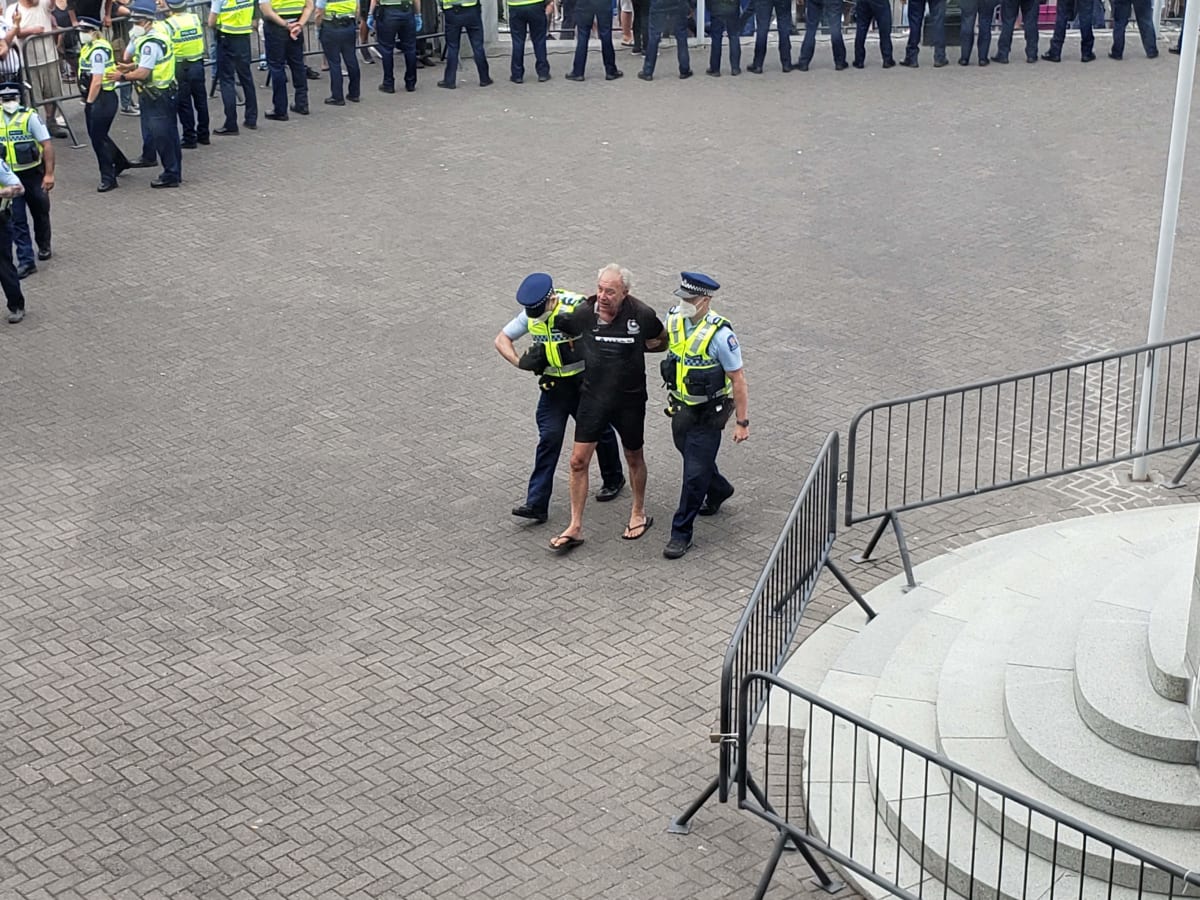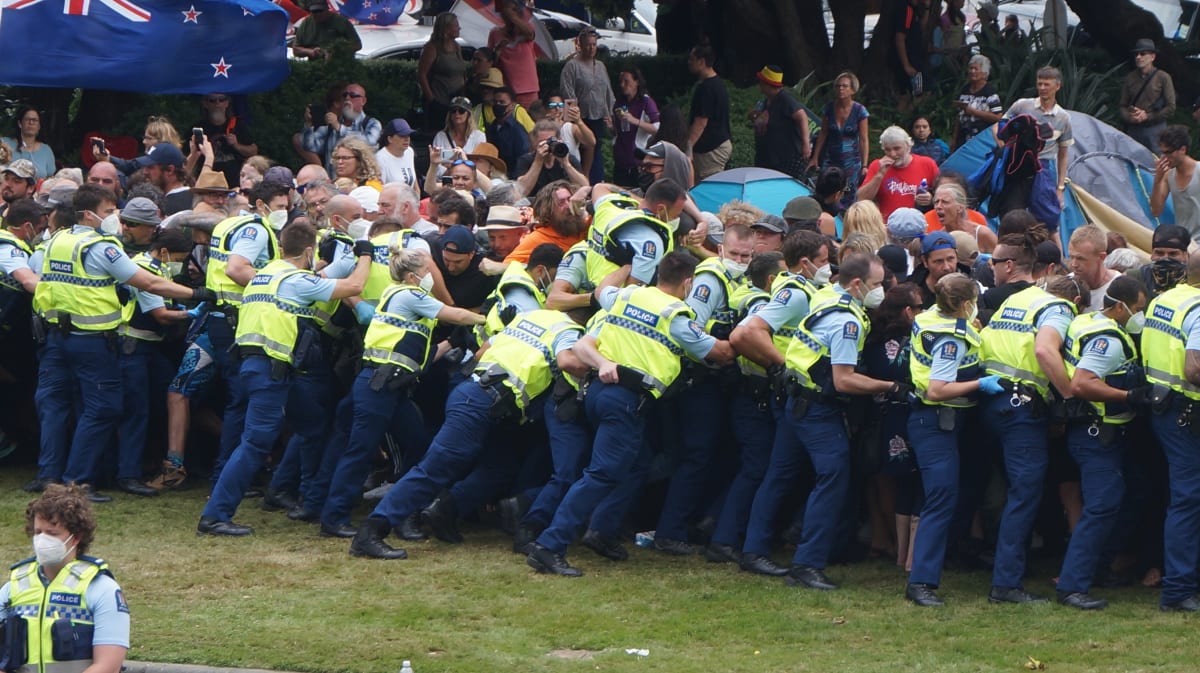
Days of protesters' chats reveal the inside story of how New Zealand's convoy was hijacked by the far-right fringe, Marc Daalder reports
Special report: The convoy wasn't supposed to end this way.
What organisers hoped would be a mass movement shutting down the nation's capital until vaccine mandates were removed has devolved into a few hundred radical protesters scrapping with police, death threats against politicians which is keeping any MPs from turning out to speak with the aggrieved, and the hijacking of the event by a Trump-aligned alternative media outlet.
Analysis of posts on the chat app Telegram as well as more traditional social media platforms shows how the convoy went from a targeted protest of vaccine mandates to a vehicle for fringe and even violent extremist ideologies over the course of the event. Pleas from the original organisers on Thursday morning to abandon the camp went unheeded and more than 100 people were arrested. At the end of the day, however, protesters cheered when police gave up all of the ground they had gained through painstaking, inch-by-inch advances.
As the occupation stretches into its fifth day, it is now being seen in starkly different ways by extremists on the ground, by a more moderate anti-mandate minority and by the general New Zealand public.
"There's something going on here that's actually quite disturbing, in terms of splintered realities and lack of a shared narrative," Sanjana Hattotuwa, who monitors extremism and misinformation in New Zealand for Te Pūnaha Matatini's Disinformation Project, told Newsroom.
While police are now managing the physical event on the ground, the battles being fought over narrative online threaten to further fray New Zealand's social fabric, he warned.
A viral moment
The speed at which the convoy went from an event in Canada to an online discussion in New Zealand to something that was actually happening is unprecedented in the country's conspiracy scene.
Hattotuwa first noticed discussion around the convoy on New Zealand-based Telegram channels on January 30. The next day, a private Facebook group to support the effort already had 7200 members. It now has nearly 70,000.
"It was first chatter about a convoy and then it became the convoy as its amorphous organisers wanted it to become. And that took less than 48 hours. It was fast," he said.
"We're looking at a propagation from ideation online on the 30th of January to what we have now. That's very, very fast."
At the time the plans were launched, the truckers' occupation of Ottawa was the big story on the anti-vax fringe and the far right globally. Efforts everywhere sought to emulate its success. In New Zealand, early attempts to recruit significant numbers of truckers failed, so the movement quickly became a convoy of regular vehicles.
We now know that Canada's convoy was not an organic uprising of truckers but the scheme of a QAnon conspiracy theorist. In New Zealand, there are no signs yet that the convoy movement was launched by any of the usual conspiracy theorist or extremist suspects.
"This was pretty organic. It came from nowhere," Hattotuwa said. It received early support and amplification from the anti-lockdown, anti-vax group Voices for Freedom and then went truly viral on the conspiracy fringe when it got coverage from Counterspin Media.
Convoy's big tent
Within a matter of days, Counterspin and the convoy's organisers would be locked in a struggle for control of the narrative around the protest as well as the physical event itself. But at that early stage, the organisers were grateful for the signal boost.
Counterspin is one of the largest platforms for conspiracy theories and far-right ideology in New Zealand. It airs on an online TV channel set up by former Donald Trump advisor and far-right extremist Steve Bannon and was started by Kelvyn Alp, an extremist known for agitating for armed resistance against the New Zealand government in the early 2000s.
Alp hasn't grown any more moderate in the interim. On January 30, the day the convoy discussions really picked up, he put out a call for armed kidnapping of MPs, journalists and anyone else his audience might perceive as upholding the Government. That statement was amplified across Telegram, but was drowned out the next day by convoy chatter. Every single one of more than 100 Telegram channels surveyed by Hattotuwa mentioned the convoy in some capacity that day.
For their part, the convoy organisers tried to keep to a narrow message: They wanted the end of vaccine mandates, the repeal of Covid-19-related legislation and for anti-vaccination doctors suspended by the Medical Council to be reinstated. While Counterspin framed the event as the start of a "war" in which politicians would be arrested for the "crime" of promoting vaccination, the organisers asked that views not related to the mandates be shared privately.

There were early warning signs of division. As the convoy made its way down the country, some users on Telegram complained about the use of Trump- and QAnon-related imagery by some vehicles.
"They are completely irrelevant and only serve to discredit the entire cause," one user wrote.
Fractures also appeared on Zello, an app that replicates a walkie-talkie which the convoy used to coordinate logistics and keep entertained for the drive to Wellington. This forum was more strictly controlled by the organisers, however, with several people complaining on Telegram that they had been kicked out of the Zello groups.
Notwithstanding these occasional disagreements, the movement's unity held as it arrived in Wellington. The first day saw participants busy setting up tents and occupying the Parliamentary precinct, with little time available for ideological scuffles.
They got tacit support from politicians like Winston Peters as well as white supremacist groups like Action Zealandia. While the organisers' official communications focused on unity, others used the platform to call for a siege of an animal vaccine factory in Timaru. At the event, signs about love and community sat alongside references to executions of politicians. Some protesters brought nooses with them.
Online, content moved like lightning in this period, Hattotuwa observed, spreading across platforms and then bouncing back with new and more extreme falsehoods appended, before beginning the cycle anew. But the differences of opinion didn't lead to direct conflict. For a day, the big tent was holding.
'Never coming back'
The decisive moment came on Wednesday afternoon. Four days prior, a conspiracy theorist by the name of Brett Power had lodged a civil complaint against Andrew Little in the High Court in New Plymouth, accusing the health minister of murder. Like many of the protesters and high-profile extremists like Alp, Power is a sovereign citizen who believes that the Government has no legal power to tax or detain him.
After filing his papers at the High Court, Power and others had attempted to storm the offices of the Taranaki Daily News. He joined the convoy and ended up in Wellington on Tuesday.
At 3.15pm on Wednesday, Power attempted to breach the police line at Parliament to enter the building and serve his legal papers to Little. The plan was then to citizens arrest the health minister - effectively, to kidnap him - and then put him on trial. The preordained punishment was to be execution.
As Power tried to push past the officers, protesters surged forward. At least one metal barricade was knocked over. The convoy's original organisers called for calm on Zello, Counterspin pushed others to storm Parliament on the livestream and on Telegram and a new faction of protesters aligned with Brian Tamaki's anti-vax Freedom and Rights Coalition (FRC) seized control of the PA system to also call for calm.

Power and two others were arrested.
Hattotuwa saw this as the clear point where the convoy's original organisers lost all control.
"When you were looking at Counterspin and listening to what was being talked about by them on Zello, they had lost the plot."
Byron Clark, a video essayist who monitors New Zealand's extreme right, said that Counterspin's influence over the crowd was evident at that moment.
"They've expanded their audience and appear to be having a lot of influence on that new audience. When the three people broke the police line, that was after Kelvyn Alp had told people to go up the steps to Parliament and do this citizens arrest of the health minister."
Angry online exchanges between Counterspin and the FRC made headlines in the mainstream media, but few noticed that the official organisers were effectively in the dark after Wednesday. Thursday morning entrenched that position.
As police began pushing onto Parliament grounds in an effort to remove tents at around 8:30am, Counterspin agitators called for protesters to form a human barrier against the officers. The official convoy organisers blared in all caps on their Telegram channel "EVERYONE NOW PLEASE WALK AWAY BACK TO THE ROAD". Instead, the protesters pushed back and the arrests started.
"It's like two different worlds. There is no connection to ground reality anymore," Hattotuwa said.
"The last I heard from the organiser, who was a woman, was that she was walking to her car and never coming back."
Counterspin takes control
Police have since expressed frustration with the lack of official leadership at the event, saying it makes it difficult for them to liaise with the crowd. They also issued a statement on Friday attempting to rebut legal misinformation that the crowd had received.
"Some factions are actively promoting false advice about people’s rights and police powers, which is misleading and factually incorrect," Wellington District Commander Corrie Parnell said.
"For example, the use of a particular word or phrase by an individual will not impact the arrest of anyone involved in unlawful activity."
When arrests resumed on Thursday afternoon, the speaker on the megaphone advised, "If you say 'I do not consent, I do not understand' three times, the police have to release you".

Clark said this was straight from the sovereign citizen playbook and further evidence of Counterspin's growing influence. That was worrying if people had joined the convoy based on its more moderate aims and were now being radicalised right on Parliament grounds.
"It pulled in new people but in doing that has brought them into this space where they're encountering more extreme ideas and more conspiratorial ideas, like the various sovereign citizen style conspiracy theories. They're now believing that police can't arrest them if they say the right thing three times. People are being pulled in and either further radicalised or at least further misinformed with more and more disinformation that's being spread around," he said.
"I think the influence of Counterspin is quite visible in what's happening on the ground. So they're not just reporting on the protests but kind of shaping the direction of the protests with their livestreams."
The void left by the original organisers is being filled with more and more extreme content, Hattotuwa said.
"It's not surprising to me that you have the ineptitude of the organisers being hijacked by elements within the country and possibly outside as a vehicle to push their own agenda. That's actually more worrying to me than the convoy."
The size of Counterspin's captive audience isn't something it would have been able to summon by itself two weeks ago. But because the convoy tried to hold both moderate and extreme elements under the same roof, the whole house has now been seized by the extremists.
There are still clear divides among the protesters. On Thursday afternoon, Counterspin streamed a protester who was being interviewed by a 1News crew. The woman talked about how she was leaving her husband because he had had the booster shot and she was certain he would die from it.
Counterspin called the woman a "Kiwi Patriot", but others watching the stream worried she would discredit the movement.
"Stop going on about conspiracies tell the MSM we are here for freedom of choice," one wrote.
Another tried to strike a middle ground between conspiracism and rationality. "Forget the conspiracies, tell them about the mandates, the vac injury, the vac deaths."
Splintered realities
On Facebook, at least, the traditional media might not have been mainstream anyway on Thursday.
"This is hitting, hard, social cohesion right now."
Hattotuwa said the Covid-19 misinformation pages he tracks on Facebook had more interactions on Thursday than the mainstream media pages - and nearly as many video views. The leading misinformation page, run by anti-vaxxer Chantelle Baker, garnered more video views with five posts than the leading media page, the NZ Herald, got with 73.
"I don't think people realise how consequential Thursday was. Not so much for what happened in front of the Beehive, though arguably that's what people are most fixated on. But it's the informational landscape. It's extraordinary," he said.
"Chantelle Baker is, with five videos, generating more video views than 73 videos put out by NZ Herald in the same 24-hour period. There are dynamics here that are unprecedented. You are talking about a small misinfo/disinfo community who are pushing out real-time footage and coverage and framing about something that is happening that is fundamentally different to what the mainstream media is putting out.
"And they are being engaged on parallel and par with the mainstream media who obviously have a larger following. There's something going on here that's actually quite disturbing in terms of splintered realities and the lack of a shared narrative."
These splintered realities risk setting us on the course towards splintered societies, Hattotuwa said.
"There are three different ways the convoy is being perceived and I cannot stress that enough. There is nothing that remotely connects what Counterspin is putting out about the convoy, in real time, to what the convoy's chatter on Zello is, like for example at the start of Thursday. It's totally disconnected.
"This is hitting, hard, social cohesion right now. It's a very sophisticated playbook. It is not original because it has been played out in developing countries like mine and also on both sides of the Atlantic, but here, it's playing out right now."
Hattotuwa compared the protest to a terror attack, not because of the physical impact on people but because of the social and political impact on New Zealand as a whole. He said the Government's social cohesion work programme, still under development in the aftermath of the March 15 mosque shootings, would be needed for this type of situation. The more social cohesion frays, the harder it is to rein in violent extremism - a lesson he learned from his home country of Sri Lanka.
"That is what keeps me up at night, because you're talking to a person who comes from a very different context. I come from the end point of where this leads. When you come from the end point of a journey, you realise the markers of how you got there," Hattotuwa said.
"What I'm seeing right now – of course it's not destiny – but what you're seeing is the inexorable traversing of a journey that will take you to not a good place. That is the problem. That is what worries me. It's not prophecy, but it is prescience because of the experience that we have been through elsewhere."







